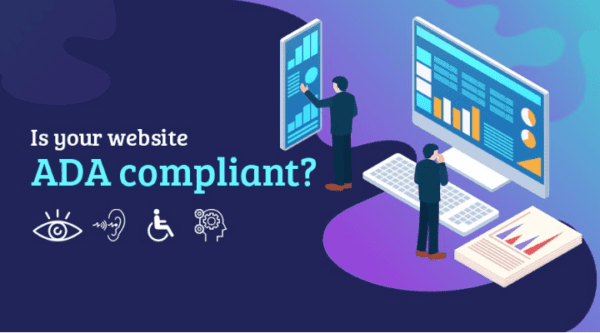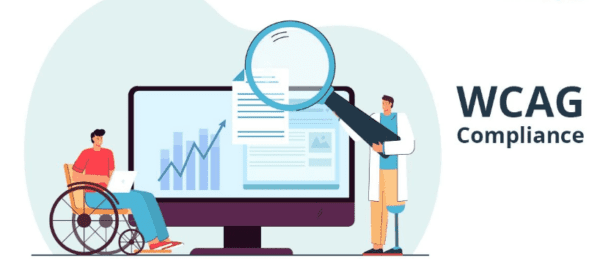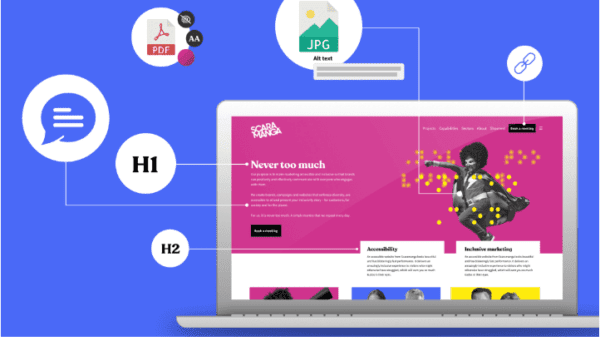If you own a website, it’s essential to ensure it is accessible to everyone, including people with disabilities. In the United States, the Americans with Disabilities Act (ADA) requires that businesses and organizations make their websites accessible to people with disabilities. Failure to comply with this law can result in legal action and fines.
An ADA-compliant website means it meets the standards set forth by the ADA for website accessibility. This includes ensuring that people with disabilities can easily navigate and use your website. The goal of an ADA-compliant website is to ensure everyone has equal access to the information and services provided on your website.
Website accessibility is an important issue affecting many of the population. According to the World Health Organization, approximately 15% of the world’s population has some form of disability. This includes people with visual, auditory, physical, and cognitive disabilities. By making your website ADA-compliant, you can ensure that you are not excluding this significant portion of the population from accessing your website and the services you provide.

Understanding ADA Compliance
Creating an ADA-compliant website means making it accessible to people with disabilities, including those with visual, auditory, physical, and cognitive impairments. The Americans with Disabilities Act (ADA) is a civil rights law that prohibits discrimination against individuals with disabilities in all areas of public life, including jobs, schools, transportation, and all public and private places open to the general public.
The Legal Framework
The ADA is divided into three titles: Title I covers employment, Title II covers state and local government, and Title III covers public accommodations. Websites are covered under Title III, which requires that all businesses open to the public provide “full and equal enjoyment” to individuals with disabilities. The Department of Justice (DOJ) enforces ADA regulations for websites and has consistently assumed that the ADA applies to web content since 1996.
Importance for Businesses
Ensuring your website is ADA-compliant is a legal requirement and an intelligent business decision. Making your website accessible to everyone, including those with disabilities, can increase your customer base and improve your reputation. Moreover, staying ADA-compliant can safeguard businesses from legal challenges and demonstrate a commitment to equal access for all.
To make your website ADA-compliant, follow the Web Content Accessibility Guidelines (WCAG) 2.0, widely accepted as the standard for web accessibility. The guidelines are organized around four principles: perceivable, operable, understandable, and robust. By following these guidelines, you can ensure that your website is accessible to everyone, regardless of their abilities.
Creating aADA-compliant website is a legal requirement and a responsible business decision. By following the WCAG 2.0 guidelines, you can ensure that your website is accessible to everyone and can avoid legal challenges doing so.

WCAG Guidelines and Levels
To ensure your website is ADA-compliant, follow the Web Content Accessibility Guidelines (WCAG) developed by the World Wide Web Consortium (W3C). These guidelines are divided into three levels of conformance: Level A, Level AA, and Level AAA. Each level has guidelines for making your website accessible to people with disabilities.
Perceivable
Perceivable guidelines ensure your website’s content is accessible to all users, including those with visual or hearing disabilities. This includes providing text alternatives for non-text content, such as images and videos, and providing captions and transcripts for audio content.
Operable
Operable guidelines ensure your website’s interface is accessible to all users, including those with mobility or cognitive disabilities. This includes providing keyboard navigation, giving users enough time to complete tasks, and making navigating and finding content on your website easy.
Understandable
Understandable guidelines ensure that your website’s content and interface are easy to understand for all users, including those with cognitive or learning disabilities. This includes using clear, straightforward language, providing instructions and feedback, and avoiding confusing or distracting content.
Robust
Robust guidelines ensure your website’s content and code are compatible with various assistive technologies, such as screen readers and voice recognition software. These guidelines include using standard HTML and CSS, providing alternative content for non-supported technologies, and ensuring your website is compatible with the latest web browsers.
By following the WCAG guidelines, you can ensure that your website is accessible to all users, regardless of their abilities. It is important to note that Level AA conformance is the minimum requirement for ADA compliance. However, striving for Level AAA conformance can provide additional benefits for users with disabilities.

Design and Technical Considerations
Building an ADA-compliant website involves design and technical considerations that ensure the site is accessible to all users, including those with disabilities. Here are the critical design and technological considerations.
Navigational Structure
Your website’s navigational structure is essential for ensuring ADA compliance. A clear, concise, consistent navigational structure helps disabled users find the content they need quickly and easily. Consider organizing your content using headings, subheadings, and lists.
Visual Design and Contrast
Visual design and contrast are critical aspects of an ADA-compliant website. Ensure your website has a clear and consistent graphic design that is easy to read and understand. Use high-contrast colours to make text and images stand out, and avoid using them alone to convey information.
Content and Multimedia
The content and multimedia on your website must be accessible to all users, including those with disabilities. Use clear and concise language to convey your message, and avoid using complex or technical terms that may be difficult to understand. Include alternative text (alt text) for all images, and provide captions for videos and audio content. Ensure your website is compatible with screen readers and other assistive technologies commonly used by people with disabilities.
In addition to the above considerations, choosing appropriate fonts and font sizes that are easy to read is essential, especially for users with visual impairments. Also, consider users with colour blindness and ensure your website is designed with their needs in mind. Considering these design and technical considerations, you can create an ADA-compliant website accessible to all users, regardless of their abilities.
Developing Accessible Content
When creating content for your website, it is vital to ensure it is accessible to everyone, including those with disabilities. This means your content should be designed with accessibility from the outset. This section will discuss some best practices for developing accessible content.

Textual Alternatives and Readability
One of the most important considerations when developing accessible content is ensuring that all images and other non-textual elements have appropriate textual alternatives. This includes adding alt tags to images, which describe the image for those who cannot see it. In addition, ensuring your content is readable and easy to understand is essential. This means using clear, straightforward language, avoiding complex jargon, and breaking up large blocks of text into smaller paragraphs.
Interactive Elements
Interactive elements such as forms, buttons, and menus should be designed with accessibility in mind. This means they can be navigated using a key, and clear and concise instructions are provided. In addition, any input should be identified and described so users can quickly correct them.
When developing interactive elements, you should also consider using ARIA (Accessible Rich Internet Applications) attributes. These attributes can provide additional information about the purpose and function of interactive elements to users of assistive technology, such as screen readers.
By following these best practices for developing accessible content, you can ensure that your website is accessible to everyone, regardless of their abilities. This will help to create a more inclusive online experience for all users.
Legal and Policy Implications
Creating an ADA-compliant website is not only the right thing to do but is also required by law. Failure to comply with the Americans with Disabilities Act (ADA) can result in lawsuits, demand letters, and costly settlements. This section will discuss the legal and policy implications of not having an ADA-compliant website and best practices for compliance.

Avoiding Litigation
Lawsuits related to ADA website compliance have increased in recent years. In 2019e, over 11,000 ADA website accessibility lawsuits were filed in the United States. These lawsuits can be costly, with legal fees ranging from $10,000 to $100,000 or more, depending on the case’s complexity.
One way to avoid litigation is to conduct regular accessibility audits to ensure your website is updated with the latest accessibility guidelines. Another way is to have a compliance checklist in place to ensure that your website meets all the requirements of the ADA.
Best Practices for ADA Compliant Website
The Department of Justice (DOJ) has issued guidance on web accessibility and the ADA. The DOJ recommends that websites comply with the Section 508 Standards, which provide technical standards for website accessibility.
Some best practices for compliance include:
- Providing alternative text for images and other non-text content
- Ensuring that all website functionality is accessible using a keyboard
- Providing captions and transcripts for audio and video content
- Using high-contrast colors to improve readability
- Ensuring that all forms are accessible to screen readers
- Providing clear and concise instructions for completing tasks on the website
By following these best practices, you can ensure your website is accessible to all users, including those with disabilities. This not only helps you avoid legal trouble but also improves the user experience for all visitors to your website.
